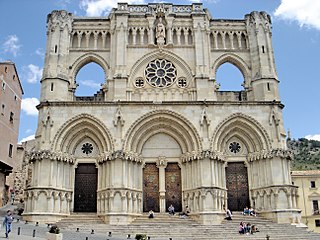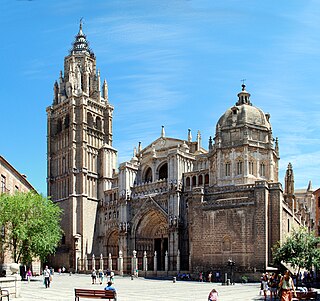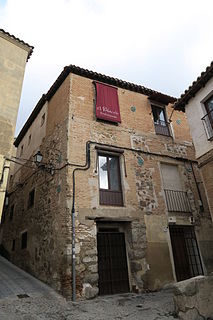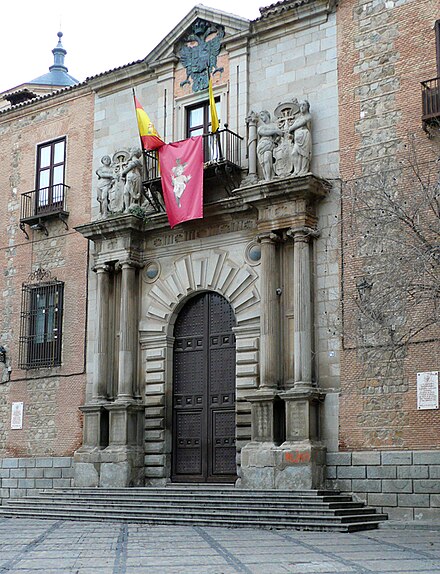
The Cathedral of Saint Mary of Burgos is a Catholic church dedicated to the Virgin Mary located in the historical center of the Spanish city of Burgos. Its official name is Santa Iglesia Catedral Basílica Metropolitana de Santa María de Burgos.

Cuenca Cathedral is a Gothic cathedral in the city of Cuenca, located in the Province of Cuenca in the Castile-La Mancha region of south-eastern central Spain. The building is one of the earliest Spanish examples of Gothic architecture, built at a time when the Romanesque style predominated in the Iberian Peninsula. In particular, the cathedral is characteristic of the Norman and Anglo-Norman architecture of the 12th century, of which Soissons Cathedral, Laon Cathedral and Notre-Dame de Paris are representative examples.

Sigüenza is a city in the Serranía de Guadalajara comarca, Province of Guadalajara, Castile-La Mancha, Spain.

The Mosque of Cristo de la Luz is a former mosque in Toledo, Spain. It is the one of the ten that existed in the city during the Moorish period. The edifice was then known as Mezquita Bab-al-Mardum, deriving its name from the city gate Bab al-Mardum. It is located near the Puerta del Sol, in an area of the city once called Medina where wealthy Muslims used to live.

Foligno Cathedral is a Roman Catholic cathedral situated on the Piazza della Repubblica in the center of Foligno, Italy. The cathedral, built on the site of an earlier basilica, is dedicated to the patron saint of the city, the martyr Felician of Foligno, who was buried here in 251 AD. It is the seat of the Bishop of Foligno.

The Colegio de Doncellas Nobles is a former girls' school in Toledo. It was founded in 1551 by the archbishop of Toledo and cardinal Juan Martínez Silíceo. The project, which had as its patron the king Philip II as well as the archbishop, had as its object the education of young women to be good mothers. Some came from humble families and others from noble families from all over Europe. They were expected to be of "clean blood". Funding was provided for the dowries of former pupils.

The Palace of Iturbide is a large palatial residence located in the historic center of Mexico City at Madero Street #17. It was built by the Count of San Mateo Valparaíso as a wedding gift for his daughter. It gained the name “Palace of Iturbide” because Agustín de Iturbide lived there and accepted the crown of the First Mexican Empire at the palace after independence from Spain. Today, the restored building houses the Fomento Cultural Banamex; it has been renamed the Palacio de Cultura Banamex.

La Santísima Church is located 12 La Santísima Street at corner of Emiliano Zapata Street in the historic center of Mexico City. Its full name is Church and Hospital of the Most Holy Trinity. The church was built between 1755 and 1783 as a temple for the adjoining hospital/hospice for priests. The hospital functioned until 1859, when the Reform Laws nationalized much of Church's property in Mexico. The church still retains its original function but the adjoining hospital and office sites have since moved into private hands with only parts of the original structures still intact and preserved.

The Cathedral of Sigüenza, officially Catedral de Santa María de Sigüenza, is the seat of the bishop of Sigüenza, in the town of Sigüenza, in Castile-La Mancha, Spain. It was declared Bien de Interés Cultural in 1931.

The Primate Cathedral of Saint Mary of Toledo, otherwise Toledo Cathedral, is a Roman Catholic church in Toledo, Spain. It is the seat of the Metropolitan Archdiocese of Toledo.

Purism is an initial phase of Renaissance architecture in Spain, which took place between 1530 and 1560, after Isabelline Gothic and prior to the Herrerian architecture in the last third of the 16th century. The name "Prince Philip" refers to the period in which Philip II of Spain had not yet received the inheritance of the Spanish Monarchy by abdication of his father, the Emperor Charles V (1556). The name "Serlian" is due to the influential architect and treatise Sebastiano Serlio.

The Palacio de la Ribera was the summer residence of Philip III in Valladolid. It was built in the 17th century (1602-1605) as part of a process of urban transformation upon the establishment of the Spanish Court in Valladolid between 1601 and 1606. The palace was situated at the Huerta del Rey neighborhood, located across the Parque de las Moreras on the right bank of the Pisuerga river. The palace grounds extended from the Puente Mayor to Ribera de Don Periáñez del Corral and delimited at both sides by the Pisuerga river and the Camino del Monasterio del Prado. The palace was gradually abandoned until it became part of the destroyed cultural heritage of Valladolid in 1761. Some ruins of the building are still preserved.

The Templar House in Toledo, in Castile-La Mancha, Spain, was built and decorated between the years 1085 and 1114, belonging to this period the general structure, typically Al-Andalusian, supported by the vaults of the basement and organized around the courtyard. The strict contemporaneousness existing between this monument of Toledo, the Aljafería palace of Zaragoza (1046–1082), and the roofing of the church of San Millán of Segovia is shown by the fact that the large majority of the construction elements for the roofs and ornamental designs are practically the same on all three buildings.

The Church of San Idelfonso is a Baroque style church located in the historic center of the city of Toledo, in Castile-La Mancha, Spain. It is also known as the Jesuit church and is consecrated to Saint Ildefonso of Toledo, patron of the city and Father of the Church.

The Colegio de Nuestra Señora de los Infantes is a school in the city of Toledo. It was founded in the 16th century by Juan Martínez Silíceo, Archbishop of Toledo and later a cardinal.

The Convento de los Carmelitas Descalzos is a Discalced Carmelite convent dating to 1643 located in the city of Toledo (Castile-La Mancha, Spain. Azulejos panels from the 18th century covers the central nave and the chapels. The altarpieces was introduced from other buildings.

The Palace of Fuensalida, is a palace located in city of Toledo built at the end of the first half of the 15th century by Pedro López de Ayala, the first lord of Fuensalida, is a great example of the Toledan Mudéjar, a historical typology that is scarce in Toledo built heritage, where merge three styles: Gothic, Plateresque and Mudéjar.

The Palacio de Benacazón is a palace located in the city of Toledo, in Castile-La Mancha, Spain.

The Hospital del Nuncio Nuevo is a Neoclassical hospital located in city of Toledo, in Castile-La Mancha, Spain. It was commissioned by Cardinal Lorenzana at the end of the 18th century. Built to house people with mental illness, it represents an advanced hospital architecture for its time.

The Palacio del Marqués de Malpica is a building in the city of Toledo, Castile-La Mancha, Spain. It's located at the Plaza de Santa Clara and next to the monastery of the same name. It is of Renaissance style and belonged to the Marquis of Malpica y Valdepusa.























